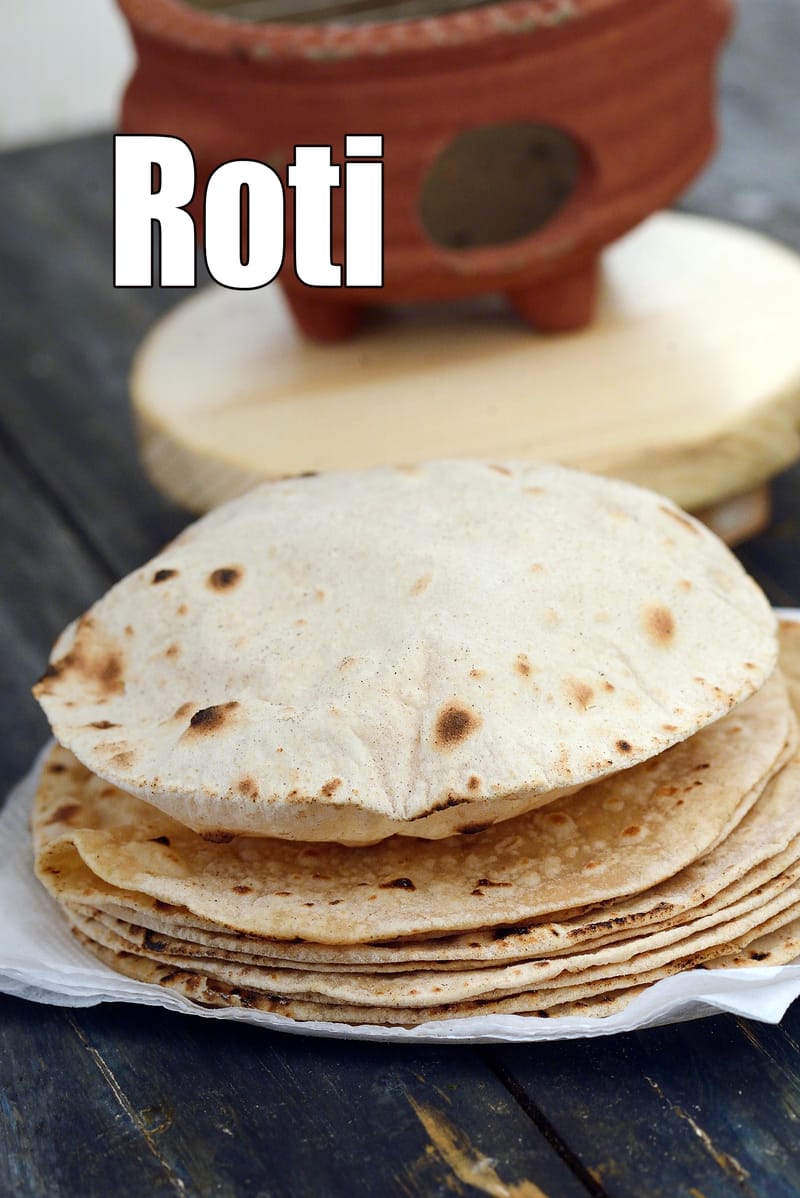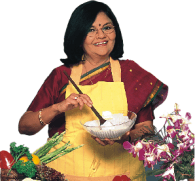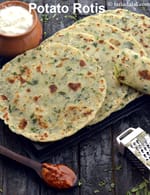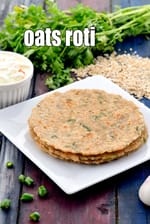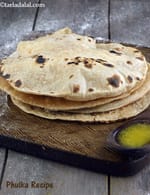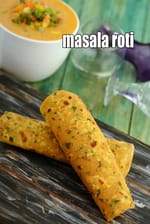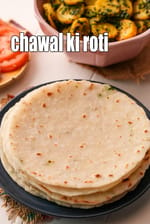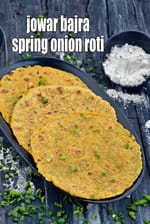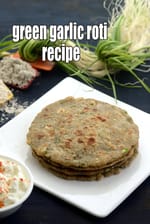roti recipe | chapati recipe | phulka recipe | how to make soft roti | Indian roti |
Table of Content
roti recipe | chapati recipe | phulka recipe | how to make soft roti | Indian roti | with 15 amazing images.
Roti is the daily bread for millions of Indians. No meal is complete without phulka and we show you easy it is to make them. All ingredients to make roti recipe is easily available in Indian kitchens.
To make roti recipe, combine the whole wheat flour, oil and salt and knead into a smooth soft dough using enough water. Keep aside for 15 to 20 minutes. Cover and keep the dough aside for 15 to 20 minutes. Divide the dough into 8 equal portions and roll out each portion of the dough into a thin circle. Cook the roti on a non stick tava and then cook it on an open flame till it puffs up. This is how to make soft roti.
I would like to share some important tips to make the perfect roti recipe. 1. To make the roti dough, you will need a thali called parat, i.e. a stainless steel flour dough kneading plate. In this plate the flour won’t spread and fall off and also will be easy to knead the dough. 2. When adding water, taking care to add water little by little as required or else the dough will be sticky and difficult to knead. The quantity of water depends upon the quality of flour. 3. The dough for rotis should be soft and not stiff as for puris. Also if the dough is very soft it will be sticky and you will be unable to roll. 4. Rolling the roti is not as difficult, start rolling lightly from the centre in a circular motion. If you put a lot of pressure while rolling the roti will not roll nice and round. Use more flour for rolling if you find it difficult to roll, but not much or else the rotis will be hard. 5. Don’t cook Indian roti on the open flame for too long or else the rotis will burn and become hard.
We love rotis as they are made from whole wheat flour which is very healthy. Whole wheat flour is excellent for diabetics, heart and weight loss as they will not shoot up your blood sugar levels as they are a low GI food.
In Mumbai, plain roti is a popular Mumbai street food. Packed in a newspaper, 4 large rotis are sold for Rs 12 and is picked up by busy working Mumbai housewives who have no time to cook. Simple logic, carry your sabzi from home and buy the roti on your way to work.
Have your roti with some sukhi sabzi or quick sabzi or vegetarian curry.
Enjoy roti recipe | chapati recipe | phulka recipe | how to make soft roti | Indian roti | with detailed step by step photos and video below.
Roti ( How To Make Soft Roti Or Phulka Or Chapati)
Tags
Soaking Time
0
Preparation Time
5 Mins
Cooking Time
15 Mins
Baking Time
0 Mins
Baking Temperature
0
Sprouting Time
0
Total Time
20 Mins
Makes
8 rotis
Ingredients
For The Roti
- 1 cup whole wheat flour (gehun ka atta)
- 1 1/2 tbsp oil
- a pinch of salt
- whole wheat flour (gehun ka atta) for rolling
- ghee for smearing
Method
For thevroti
- To make the roti, combine the flour, oil and salt in a bowl and knead into a soft dough using enough water. Keep aside for 15 to 20 minutes
- Divide the dough into 8 equal portions and roll out each portion of the dough into a thin circle of 150 mm. (6”) diameter using a little whole wheat flour for rolling.
- Heat a non-stick tava (griddle) on a high flame and when hot, place the roti gently over it.
- Cook it till small blisters appear on the surface. Turn over the roti and cook for few more seconds.
- Cook it on an open flame till it puffs up and brown spots appear on both the sides.
- Repeat with the remaining dough portions to make 7 more rotis.
- Smear ghee on top of the roti and serve hot.
Roti recipe ( How To Make Soft Roti, Phulka, Chapati) Whole Wheat Roti Video by Tarla Dalal
Roti ( How To Make Soft Roti Or Phulka Or Chapati) recipe with step by step photos
-
-
In a deep bowl put 1 cup whole wheat flour (gehun ka atta). To make the roti dough, traditionally a thali called parat, i.e. a stainless steel flour dough kneading plate is used. In this plate the flour won’t spread and fall off and also will be easy to knead the dough.
-2-185443.webp-1-185443.webp?w=800&format=webp)
-
Then add 1.5 tablespoon of oil. Oil helps to bind the flour and also keeps the rotis soft.
-3-185443.webp-2-185443.webp?w=800&format=webp)
-
Then add a pinch of salt, but it’s optional. Salt is to add flavour and taste to the roti, as many people don’t like their rotis bland.
-4-185443.webp-3-185443.webp?w=800&format=webp)
-
Then add water, taking care to add water little by little as required or else the dough will be sticky and difficult to knead. The quantity of water depends upon the quality of flour.
-5-185443.webp-4-185443.webp?w=800&format=webp)
-
Keep adding water as required and knead the dough. As you keep kneading the dough you will understand how much more water to add.
-6-185443.webp-5-185443.webp?w=800&format=webp)
-
Knead and gather the dough from the sides of the parat to form a mass. Add water so that the dough is soft but not sticking to your fingers at all.

-
Check the dough for softness and add some water and oil as needed. Punch the dough with your knuckles and keep on kneading for around 2 minutes or until the dough is soft and pliable. The dough for rotis should be soft and not stiff as for puris. Also if the dough is very soft it will be sticky and you will be unable to roll.
-8-185443.webp-7-185443.webp?w=800&format=webp)
-
Keep the kneaded dough aside covered with a soft cloth or bowl for 15 to 20 minutes. If you wish you can make the rotis immediately, but I suggest keep the dough aside for some time as it gives a nice texture and the rotis will be softer and more fluffy.
-8-185443.webp-8-185443.webp?w=800&format=webp)
-
The roti dough can be refrigerated for 2-3 days. The best way to refrigerate the dough is to lightly oil the dough and the bowl. The bowl you are storing the dough should be spacious and should be covered tightly to prevent it from drying.
-9-185443.webp-9-185443.webp?w=800&format=webp)
-
In a deep bowl put 1 cup whole wheat flour (gehun ka atta). To make the roti dough, traditionally a thali called parat, i.e. a stainless steel flour dough kneading plate is used. In this plate the flour won’t spread and fall off and also will be easy to knead the dough.
-
-
To make roti recipe | chapati recipe | phulka recipe | how to make soft roti | Indian roti | Press the dough with your fingertip, and the dent that your fingers make should almost bounce back. If this doesn’t happen, it means that the dough is too hard, and it can cause the Chapati to be dry. After 20 minutes, divide the dough into 8 equal portions. Take a portion of the dough and roll between your palms and flatten it.
-1-185444.webp-1-185444.webp?w=800&format=webp)
-
Using a little whole wheat flour for rolling, start rolling out the dough till it is a thin circle of 150 mm. (6”) diameter. Rolling the roti is not as difficult, start rolling lightly from the centre in a circular motion. If you put a lot of pressure while rolling the roti will not roll nice and round. Use more flour for rolling if you find it difficult to roll, but not much or else the rotis will be hard.
-2-185444.webp-2-185444.webp?w=800&format=webp)
-
Heat a non-stick tava (griddle) on a high flame and when hot, lower the flame and place the roti gently over it. Cook it till small blisters appear on the surface. The best way to check if the tava is ready is to drizzle a few drops of water on the tawa.If it sizzles, you are ready to make your roti.
-3-185444.webp-3-185444.webp?w=800&format=webp)
-
Turn over the roti | chapati | phulka | Indian roti | and cook for few more seconds on high flame till light brown spots appear.
-4-185444.webp-4-185444.webp?w=800&format=webp)
-
Lift the roti off the tava with a tong and keep the first side that was cooked on the open flame, it will puff up.
-5-185444.webp-5-185444.webp?w=800&format=webp)
-
Turn and keep the other side on the flame for 2 second it will puff further. Don’t cook on the open flame for too long or else the rotis will burn and become hard. Repeat with the remaining dough to make more rotis.

-
Place the roti on a plate, apply ghee over the roti and serve hot or wrap in a clean soft cloth and keep them in a hot case. Serve with subzis, curries and dal.
-7-185444.webp-7-185444.webp?w=800&format=webp)
-
To make roti recipe | chapati recipe | phulka recipe | how to make soft roti | Indian roti | Press the dough with your fingertip, and the dent that your fingers make should almost bounce back. If this doesn’t happen, it means that the dough is too hard, and it can cause the Chapati to be dry. After 20 minutes, divide the dough into 8 equal portions. Take a portion of the dough and roll between your palms and flatten it.
-
-
Whole Wheat Roti – Healthy for Kids and Adults Both. Yes, Roti is healthy as its made from whole wheat flour – good for one and all. Whole wheat flour is excellent for diabetics as they will not shoot up your blood sugar levels as they are a low GI food when compared to refined flour (maida). Whole wheat flour is rich in Phosphorus which is a major mineral which works closely with calcium to build our bones. Moreover wheat flour definitely has more fiber than maida. With 2 g of fiber per roti, these are a more wholesome option to serve for diabetics and those with heart diseases. Limit its intake to 2 per meal, as nothing in excess is god for health. Hypertensives too can enjoy these rotis, provided they avoid adding that salt while kneading the dough. With a smear of ghee, these can be served to kids as well. Small quantities of ghee are necessary to lubricate the joints in the body and provide nourishment to their developing brain cells.

-
Whole Wheat Roti – Healthy for Kids and Adults Both. Yes, Roti is healthy as its made from whole wheat flour – good for one and all. Whole wheat flour is excellent for diabetics as they will not shoot up your blood sugar levels as they are a low GI food when compared to refined flour (maida). Whole wheat flour is rich in Phosphorus which is a major mineral which works closely with calcium to build our bones. Moreover wheat flour definitely has more fiber than maida. With 2 g of fiber per roti, these are a more wholesome option to serve for diabetics and those with heart diseases. Limit its intake to 2 per meal, as nothing in excess is god for health. Hypertensives too can enjoy these rotis, provided they avoid adding that salt while kneading the dough. With a smear of ghee, these can be served to kids as well. Small quantities of ghee are necessary to lubricate the joints in the body and provide nourishment to their developing brain cells.
-
-
We thought we would show you how Mumbai roadside rotis are sold. Roti's are wrapped in newpapers and sold as Mumbai street food by the vendors .
-1-187320.webp?w=800&format=webp)
-
You can see that there are 4 large roti's of 8" inch diameter. They cost Rs 12 for 4 roadside rotis.
-2-187320.webp?w=800&format=webp)
-
This is how the street style roti's look. Note that the roti's are not smeared with ghee. These roti's will remain soft since they have been wrapped properly. One suggestion : Don't re-heat the roti's as they'll harden.

-
We thought we would show you how Mumbai roadside rotis are sold. Roti's are wrapped in newpapers and sold as Mumbai street food by the vendors .
-
- To make the roti dough, you will need a thali called parat, i.e. a stainless steel flour dough kneading plate. In this plate the flour won’t spread and fall off and also will be easy to knead the dough.
-
When adding water, taking care to add water little by little as required or else the dough will be sticky and difficult to knead. The quantity of water depends upon the quality of flour.
-5-185443-2-192916.webp?w=800&format=webp)
-
The dough for rotis should be soft and not stiff as for puris. Also if the dough is very soft it will be sticky and you will be unable to roll.
-8-185443-3-192916.webp?w=800&format=webp)
-
Rolling the roti is not as difficult, start rolling lightly from the centre in a circular motion. If you put a lot of pressure while rolling the roti will not roll nice and round. Use more flour for rolling if you find it difficult to roll, but not much or else the rotis will be hard.
-2-185444-4-192916.webp?w=800&format=webp)
-
Don’t cook Indian roti on the open flame for too long or else the rotis will burn and become hard.
-5-185444-5-192916.webp?w=800&format=webp)
-
-
roti, phulka, chapati for heart, diabetics and weight loss. Prepare the roti as given above and ideally don't add any ghee to it. For heart patients, diabetics they are allowed minimum oil, ghee which is 3 tsp per day. So limit your total usage per day.

- Serve roti (phulka, chapati ) with low fat curds to increase the protein content.
-
roti, phulka, chapati for heart, diabetics and weight loss. Prepare the roti as given above and ideally don't add any ghee to it. For heart patients, diabetics they are allowed minimum oil, ghee which is 3 tsp per day. So limit your total usage per day.
Nutrient values (Abbrv)per plate
Nutrient values (Abbrv) per roti
| Energy | 80 cal |
| Protein | 2 g |
| Carbohydrates | 11.8 g |
| Fiber | 1.9 g |
| Fat | 3.1 g |
| Cholesterol | 0 mg |
| Sodium | 3.2 mg |
Click here to view Calories for Roti ( How To Make Soft Roti Or Phulka Or Chapati)
The Nutrient info is complete
A J
May 5, 2021, 10:40 a.m.
My rotis were unedible until you taught me how! Thank you thank you thank you!
Tarla Dalal
May 5, 2021, 10:40 a.m.
Hi, Thank you for your kind words. Do try more and more recipes and let us know how you enjoyed them. Happy Cooking !!
Sunil Pandya
April 10, 2021, 9:59 a.m.
I have tried this recipe, how ever when I roll the roti it get break and show little whole, in middle what can be reason? Also how can I check my flour quality?
Tarla Dalal
April 10, 2021, 9:59 a.m.
Hi, Make sure when you roll the roti is not very thin. IF it is too thin it might tear from the center.
kumbakonamfiltercoffee kufico
Oct. 18, 2020, 1:43 p.m.
GOOD!!
Tarla Dalal
Oct. 18, 2020, 1:43 p.m.
Thanks so much for trying our recipe, it means a lot to us. Keep trying more recipes and sharing your feedback with us.
Vinu
Sept. 6, 2020, 9 p.m.
Tarla Dalal
Sept. 6, 2020, 9 p.m.
Thanks for the feedback !!! keep reviewing recipes and articles you loved.
Sunil Pandya
Sept. 4, 2020, 12:51 p.m.
I have tried according to this blog and video, but I am not able to do so, because I found that I utilised more water. So exactly how much glass or how much milliliter water is used to make eight roti? can anybody give information
Tarla Dalal
Sept. 4, 2020, 12:51 p.m.
Hi, Water proportion will always depend onthe quality of the flour, add little little always and knead till it is soft. see the video it will show you exactly how to knead....
Loves Food
April 16, 2020, 9:35 a.m.
This is a perfect detailed roti recipe.
Tarla Dalal
April 16, 2020, 9:35 a.m.
Thanks !
Julian Rudolph Pinto
March 8, 2020, 10:52 a.m.
Tarla Dalal
March 8, 2020, 10:52 a.m.
Julian, Thanks for the feedback. Happy cooking.
Salim
Feb. 20, 2020, 10:47 p.m.
Tarla Dalal
Feb. 20, 2020, 10:47 p.m.
Thanks for the feedback.
preethi ram
July 25, 2018, 9:42 a.m.
u can make even without oil and sidesbzi paneer makalawala
krupali
April 8, 2016, 11:28 p.m.
Roti ni aa recipe ek dam perfect recipe che, je girls navu navu cooking karva nu chalu kariti hoy to roti mate aaj recipe banvae. Pachi jojo tamri roti kevi fule che ne tamaru parivar khusi thi kahi ne aanand lai che.
Anita
Feb. 4, 2016, 5:13 p.m.
Archana M
Dec. 25, 2015, 10:33 a.m.
roti.. a must basic recipe which every one should know.. and thank you so much for this recipe.. this has taught me to make perfect soft rotis.. which stays fresh a whole day.. the measurements are so perfect that you end up making amazing rotis for the family..
